Abstract
Currently, the Israeli energy industry faces the challenge of a considerable increase in solar electricity production. As a relatively isolated system, the significant expansion of solar electricity may cause problems with electricity quality. Electrical storage installation can resolve this problem. In Israel’s situation, the optimal solution could be the creation of a channel between the Mediterranean and the Dead Sea. The channel can solve three closely related problems: the increased production of desalinated water for domestic, industrial, and agricultural needs; the prevention of a permanent Dead Sea level decline and its imminent disappearance; the development of hydro-pumping electrical storage stations; and the creation of numerous PV facilities in the Negev area for national electricity generation. However, detailed analysis should be conducted for the estimation of the possible increase in solar electric generation with consideration of a stochastic PV outcome and the potential ability to use the Dead Sea for the brine discharge of electrical hydro-storage plants.
1. Introduction
Present and future progress in the common worldwide electric industry, as well as the domestic Israeli industry, is closely related to renewable energy overall and solar PV power generation [1,2,3,4,5]. The trend of increasing usage of PV stations can be determined by factors such as environmental protection against harmful pollution typical of conventional power plants [6,7], the permanent diminishing of the costs of solar facilities [8,9], and the cost of solar electricity [10,11]. The potential of PV applications can be significantly larger with electrical storage facilities [12]. The Israeli electro-generating economy is feasibly rich with the ability to produce solar electricity, which causes the tendency to increase renewable generation usage as determined by government directives [4] with the request to achieve 30% of this total power by 2030. It is planned to increase preferences for solar electricity producers and encourage domestic storage installations. This roadmap could pave the way for the increased installation of new PV power facilities, both by private domestic consumers and big energy companies. To date, a summarized generation in the middle of the day can achieve up to 19–20% of the total national power installation. The tendency toward the increasingly widespread use of PV stations raises the natural question of feasible limits for providing consumers with solar electricity. To what extent this can be performed without diminishing the quality of the electrical supply can be questioned.
Theoretical investigations and experimental practices of PV systems show evidence of some technical problems accompanying massive applications of solar power stations. Three main obstacles prevent the wide use of PV electricity on a large scale. The first of these problems is the voltage instabilities in distribution lines that are enriched by numerous solar PV facilities [13,14,15,16,17]. Owing to the stochastic nature of solar irradiation, the power of a PV installation may change fast enough; sometimes, generating power alternates up to 20–25% from its average magnitude during 1–1.5 min only. Such generational deviations are especially problematic if they coincide at this time with fault events in the network. These circumstances cause particularly strong voltage distortions, which cannot be compensated for by special distributing transformer appliances—tap-changers in the sub-stations. It is worth reminding readers that a tap-changer is a slow-functioning electromechanical device that controls the transformation ratio through the connection and disconnection of different transformer sections and, therefore, cannot react to the fast-changing power balance in a network [18].
The AC frequency is becoming less stable, which is the second major problem caused by the widespread use of PV power stations in the domestic network. Due to numerous research works [19,20,21,22,23], the problem of frequency stability and control exists in large networks, including those with significant renewable generation, and becomes especially urgent with the increasing portion of solar electricity. A lack of electromechanical inertia in PV facilities, which helps stabilize frequency in a grid and is an actual component of conventional generators in power stations, prevents an increase in solar electricity over some limit [24]. For the island networks, this restriction stands at around 10–12%, and additional PV production requires substantial technical efforts. For most applications, the cardinal solution is the use of electric storage facilities.
The third obstacle to a significant PV intervention in the domestic network is the absence of solar activity during the night. Therefore, electric power systems should supply the missing power requirement because conventional generating facilities are based on the governance of fossil fuels. An additional obstacle to massive solar energy application is the non-homogeneous spread of domestic consumers’ electricity demands in time, which can achieve a minimum at night and a maximum in the evening hours when solar irradiation does not already exist. Owing to the restricted flexibility of conventional steam turbine generators, which can be regulated in a relatively narrow range of power, their installed capacity should be capable of providing not less than 70–80% of a total energy supply [25]. This limit can be increased mainly by the installation of massive electrical storage.
Summarizing the above, the main solution for a substantial PV energy increase can be the application of large storage facilities that are able to compensate for the missing electrical power during peak requirements and, in this way, diminish conventional power generation by minimizing its usage to some appropriate scale. Storage solutions are now rather expensive (except for the pumping hydro-storage), and this is unlikely to alter soon [26]. Furthermore, prevailing electrical storage technologies such as electrochemical, mechanical, or others (for example, superconductivity) is not scalable to requisite levels [27,28,29]. Nevertheless, a hybrid combination of solar PV generation with pumped storage may be the solution to these challenges [30,31,32,33]. Pumped hydro-storage is a viable method for large-scale energy production and provides reasonably inexpensive and adequate electricity. The practical cost of 2–3 cents per kWh is mentioned as an achievable price for hydro-pumped storage systems with more than ~100 MW of installed power. Because of these benefits, many applications of hydro-pumped appliances for renewables have been developed over the last 10–15 years [34,35,36]. Notwithstanding the benefits of hydro-storage, there are many questions about its practical application in real-world energy systems. As a result, the authors in [37,38,39] examined many techno-economic elements of optimal collaboration between solar or other renewable power generation and hydro-pumped storage. The findings of these studies pointed to a significant possibility for hydro-pumped storage in combination with renewable energy sources. However, for such systems to be effective, a proper selection of storage qualities and parameters must be made. As a result, the current restricted capabilities of various storage technologies can prevent the total abolition of fossil (or nuclear) power plants in a national network from being achieved in the next 40 to 50 years. Hence, the optimal solution seems to be the optimal combination of renewable (namely, solar) and conventional generation of electricity when added with storage systems, between which hydro-pumped power stations for Israeli conditions are preferable.
Hydro-pumped storage can ensure the growing demand for freshwater, along with clean energy production and environmental preservation. However, in the Israel region, that is mostly arid and close to two seacoasts, the lack of a freshwater supply is fulfilled by the seawater desalination process, which requires a lot of electricity [40,41,42]. Among existing desalination approaches, the utilization of reverse osmosis membranes can be promoted. The continuous advancement of this technology over time has resulted in low water costs as well as the durability of desalination plants. The desalination process is accompanied by the formation of a highly concentrated brine that must be disposed of. Nonetheless, brine is preferably discharged along the shore for economic purposes. For the time, the Mediterranean Sea is the primary source of seawater for desalination. Significant portions of brine on the eastern part of the Mediterranean offshore region, which has few mixing currents, result in a permanently saline area that harms the sea’s flora and fauna. Given the foregoing, freshwater production can be accompanied by pumped hydro-storage, which symbolizes a viable approach for balancing energy demands. For example, turbines that are capable of operating in seawater and concentrated (brine) water are already available [43] and might be used in electric systems.
The additional and significantly harmful environmental problem is the permanently decreasing level of the Dead Sea, which is causing its progressive disappearance. The Dead Sea level, as per the intensive evaporation and the absence of the Jourdan River water flow, is gradually dropping down. The disappearance of the Dead Sea may cause shattering environmental changes. As a result, the unique climate and geological conditions in the adjacent area could vanish, and the consequent negative influence of this is extremely difficult to predict.
Pumping hydro-storage can solve this problem because the brine, as a by-product, can be discharged to the Dead Sea instead of being returned to the Mediterranean. In the vicinity of the Dead Sea, the Mediterranean Sea can provide water for pumping to the Judea Mountains, where desalination plants should be established. The brine from desalination during the day is accumulated in special ponds, and later in the evening hours is dumped into the Dead Sea through a cascade of hydro-power stations producing electricity at the scale required to compensate for the electricity demand during the peak hours in the evening.
In summary, the creation of a Mediterranean-Dead Sea channel could address three critical concerns that are impeding Israel’s future progress and prosperity: a major growth in renewable electricity generation, freshwater availability, and averting the extinction of the Dead Sea. However, certain critical difficulties must be addressed, such as the best path for a channel, determining the possible growth in PV electricity, and the production of desalinated water.
This article describes an optimal approach for solving this problem. The article is organized into Section 2, which gives the statistical evaluation of its permanently decreasing level and external surface area; Section 3—the Methods represent the methodology of the optimal parameter calculation; the next Section 4—provides results and analyzes the outcome of the investigation. Section 5—Discussion—and Section 6—Conclusions—declare the important issues of the performed research work.
2. Dead Sea Review
The Dead Sea region is a unique natural water reservoir that was created millions of years ago near the Jordan Valley in the Great Syria-African Rift, which represents a break in the earth’s crust extending 6000 km from the Lebanon Mountains to Mozambique in southeast Africa. Its basin is separated from the worldwide ocean, and for millions of years, because of water evaporation and freshwater income from the Jordan River from the Lebanon Mountains, a special ecosystem was produced. This relatively constant balance between incoming and evaporating water has been destroyed during the last 80–90 years because of a reduced supply of water that is extensively used for agricultural needs and the development of mining industries that employ sea brine for different mineral productions. The relatively constant balance between incoming and evaporating water was destroyed during the last 80–90 years because of a reduced flow of water that was extensively used for agricultural needs and developing mining industries employing sea brine for different mineral productions. The result of the evaporation-supply disbalance is a permanently lowered sea level and a decrease in the sea’s surface area. The diagram in Figure 1 shows the alteration in the sea level [44]. The shrinking of the sea level surface, which diminished by about a third from 950 km2 to 620 km2 from 1960 to 2020, can be seen in Figure 2 [45]. The sea level dropped by more than 30 m, and this process continues at a rate of 1 m per year.
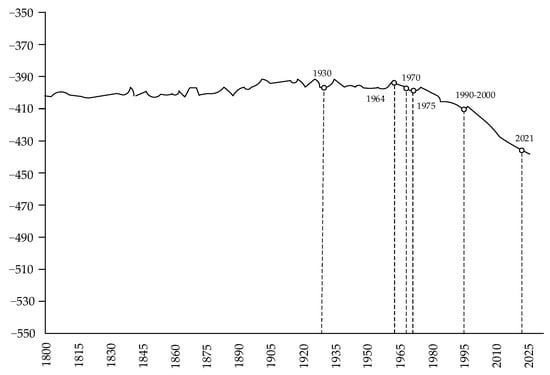
Figure 1.
The lowering of the Dead Sea water level.
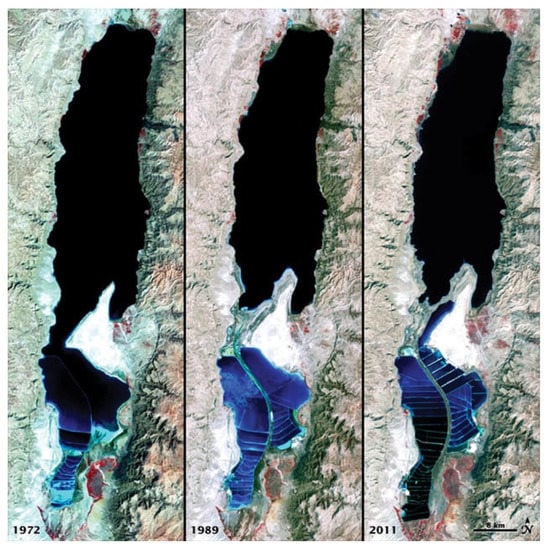
Figure 2.
The permanent decrease in the Dead Sea surface.
An important factor is the rate of water evaporation from the surface of the Dead Sea. This influences the amount of brine produced after the desalination process, which should be dumped into the sea without causing a significant rise in the water level. The extensive increase in the Dead Sea surface is not desirable since it may cause environmental problems when rapidly rising water levels flood existing structures and roads near the coast. The expression connecting the aggregate volume of evaporated water with the Dead Sea surface area is shown below [46,47]:
where: , —is the saturation vapor pressure above a freshwater surface. It is represented as a function of the temperature on the water surface and in the air; Ψ—is the relative humidity, and f(W) is the function of wind speed W obtained empirically. The saturation vapor pressure can be described [46] as follows:
where the result is obtained in mbar and θ—is the temperature in °C degrees. The corrected saturation vapor pressure is:
where coefficient β is an empirical function of salinity S. The coefficient β changes for different ionic compositions and can be determined graphically [46,47]. Considering the composition of the water (in the Mediterranean, the main ions are MgCl2 and NaCl, whereas, in the Dead Sea, KCl ions are prevalent), the coefficient β is 1.09–1.1 times bigger for the first sea region than for the other. Thus, the evaporation process of the brine after the desalination of the Mediterranean water is faster than that of the Dead Sea, as predicted by Equation (1). Hence, the decrease in water altitude could be greater than the existing 1 m/year. Therefore, the potential dumping of brine volume could be larger, and together with a gradual increase in the sea surface area because of sea level rises, the pumped hydro-storage could be much more significant.
Resuming what was mentioned above, the Dead Sea can be an excellent choice for creating hydro-pumped storage that can adopt surplus PV electricity production.
3. Methods
This section represents the total solution for the electric power system, including conventional electricity generation, renewable PV production, and hydro-power storage with desalination facilities. Further, the analysis of energy demands and optimal parameters for PV electricity and freshwater production is represented.
3.1. The Schematic Diagram of a Domestic Electric Power System Combines Conventional Generating Facilities with PV Plants and Hydro-Power Storage
There are close to 20–22 potential locations of PV station sites from the south to the north on the Israeli map. The summarized ability of the annual energy was estimated at not less than 30 TWh/year, or 18 GW of average power [47]. This magnitude of power was much greater than the maximum observed during the last 5 years and could be achieved due to a prognosis of only 2030–2035 years. Therefore, the capability to provide 25–30% of the total electricity supply from solar stations seems very realistic. However, the problems of stochastic and poorly predictable solar electricity production force us to apply storage technology. As mentioned above, the best solution could be hydroelectric storage. Taking into consideration the proximity of the Dead Sea to the Mediterranean, the best solution for hydro-pumping storage can be based on the channel between these two regions. The diagram of a channel with desalination facilities and accumulating pools in the Judea Mountains is shown in Figure 3.

Figure 3.
Schematic diagram of the hydro-pumping storage based on a channel Mediterranean-Dead Sea.
The total potential of PV installations can be accessed as per the capability of storage technology and is discussed later based on required electricity demands and the ability of the Dead Sea to assume brine water after desalination and evaporate it.
3.2. Estimation of the Dead Sea Level Increase as per the Dumping of the Sea Water
Owing to the results of Section 1, the estimation of the evaporation rate and the possible rate of brine dumping into the Dead Sea could be evaluated. These calculations were based on the linear interpolation of the surface area and evaporation. Assuming a historical alteration of the Dead Sea surface and water altitude, the surface area as per the sea level altitude can be assessed as follows:
where Δh is a water level rise, m; Htot—a total decrease in the altitude during the determined historic period; Abeg, A0—surface area at the beginning of the historic period and now, km2.
The simplified differential equation of the altitude dynamics is described by Equation (5):
where Vbrine is the rate of brine dumping into the Dead Sea, km3/year; Vevap, νevap is the quickness of the volume and surface evaporate process, km3/year, m/year in accordance. The annual evaporation rate of the altitude can be considered as a constant value equal to 1.05–1.08 m/year, as it is followed from Section 1.
The character of a solution depends on the right-hand side of Equation (5). If it is negative, the sea level continues to decrease; when it is equal to zero, the sea surface altitude remains unchangeable; otherwise, if it is positive, the sea level begins to rise. The integral of (5) and the final solution are given below:
The solution of (6) depends on the sign of the expression . If it is negative, the sea level decreases all the time, which makes no sense. If it is equal to zero, accordingly, the sea level remains constant, and the volume of a brine that can be directed to the Dead Sea is equal to:
The case of positiveness represents the most interest since it provides the possibility to increase brine dumping without negative outcomes. The sea level at the beginning of the period grows, and this is escorted by the enlarged surface area and, therefore, by the increasing evaporation velocity. After the rate at which the increase in sea level equals the evaporating velocity, the steady state when the sea level remains at the same level, takes place. The higher the brine dumping rate, the higher the steady-state sea surface altitude. Below are graphs of the altitude increase during the years to come for some brine dumping velocities.
The magnitude of a dumping rate determines several important parameters of the electric industry, which combines conventional power stations, PV plants, and hydro-pumped storage with hydro-generating facilities. In addition, it ensures the total volume of desalinated water and the amount of energy stored in hydro-pumped facilities.
3.3. Analysis of the Electricity Demands and Hypothetical Solar Electricity Production
The demand for electric power in Israel has a positive annual trend of ~3%. This tendency is set to continue, as it seems, until 2030–2035 as an answer to the growing population and industrial development. In this regard, and especially in view of the growing population density, the use of solar and other renewable energies is particularly relevant. Despite the rising electricity needs, the daily (or hourly) character of the energy supply remains relatively constant. Some deviations related to specific weekdays and holidays were neglected in our analysis. A typical diagram of domestic electricity requirements, together with conventional and renewable power production, is shown in Figure 4. The curve of the supplied power has a minimum at night and in the early morning hours, gradually rising to midday with a slight decrease afternoon. Further, the curve of electricity supply grows up once again, achieving the evening maximum and later relatively quickly slowing down to the night minimum. This type of electricity demand is rather unusual and different from the needs of European countries, for example. The widespread use of electrified public transportation in these regions can account for this distinction. It is worth remembering that nearby, all electrical needs (96–97%) are covered by conventional power plants that use gas or coal burning for steam production to activate steam turbines. The presence of solar electricity and storage hydro-pumped systems with desalination facilities in the electric industry could dramatically change the curve of generating supply power (Figure 4). First, conventional stations can be activated much more reliably, providing power in a relatively narrow range deviating from 10% to 12% up and down from the average. This circumstance is relevant as the PV production meets 25–30% of the total needs. Following this case, Section 1 (positive generation balance in the time from t4 to t2) is distinguished (Figure 5) as characterized by the surplus of conventional electricity production over requirements. The excess of power proceeds to Mediterranean water pumping at the altitudes of the Judea Mountains and freshwater production. Section 2 is next in the daytime (positive generation balance as well as in the time from t1 to t3) when power demands are covered by the summary of conventional stations together with PV facilities. This time, owing to the increased output means that the surplus of electricity is once again directed to water pumping and desalination. Later, in the evening hours, after the solar energy disappears and the time of the evening peak comes, the requirements (section of the stored energy release in the time t2–t4) are supplied by conventional power plants and hydro-pumped storage together. This time, accumulated brine is dumped into the Dead Sea through a cascade of hydroelectric stations.
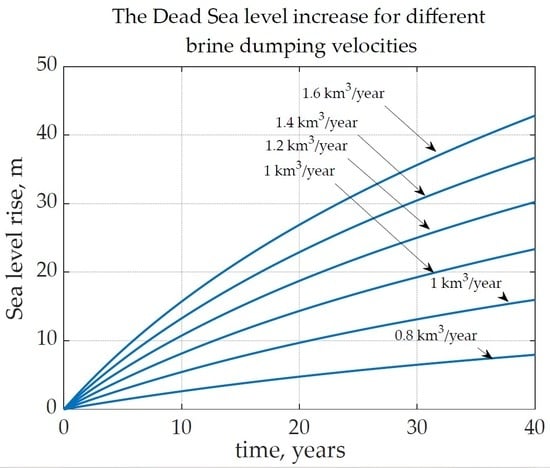
Figure 4.
The Dead Sea level rises as per different rates of brine dumping.
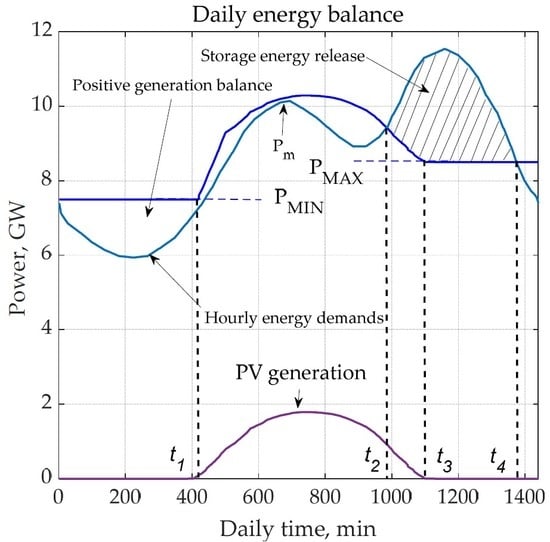
Figure 5.
Typical domestic power requirements with conventional, renewable (PV) electricity production, desalination process, and hydro-pumping storage.
The calculations of the energy balance, considering the importance of providing guidelines for channel development, are fulfilled for the averaging values of the electricity consumption and solar PV power. The average level of solar irradiation per day and net PV power per sq. m is represented below in Figure 6.
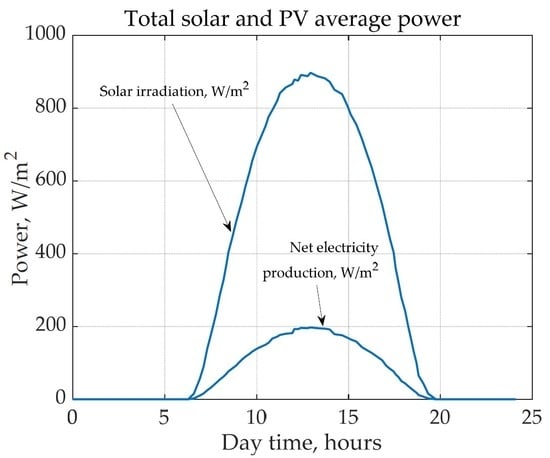
Figure 6.
Average solar irradiation and net PV power per day hours.
The primary parameter for the assessment of maximum allowable PV facilities sizing is the ultimate daily energy possibility (W) of hydro-power generation. The following expression gives the answer:
where ηHP depicts the total efficiency of hydropower stations. Today, it can achieve a value of ~0.9 (90%); however, to make sure we took 0.85 (85%) [48]; g—gravitational acceleration, 9.85 m/s2; Htot—summarized height between the upper level of a brine pool and the lowest altitude of hydropower stations in the vicinity of the Dead Sea surface, m; , the brine density [49], equal to (1.06–1.07)∙103, [kg/m3]; Vyear—maximum allowable brine dumping, km3/year. It is worth noting that the entire height of brine dumping could be defined by the unique path of a channel and ranged from the depth of the Dead Sea level beneath the Mediterranean to the height of brine lakes in the Judea Mountains. In practice, it may range from 600 m to 1000 m.
Considering the results of Figure 4 and expression (8), the total daily energy production is represented by curves in Figure 7 for different heights (Htot) of brine dumping.
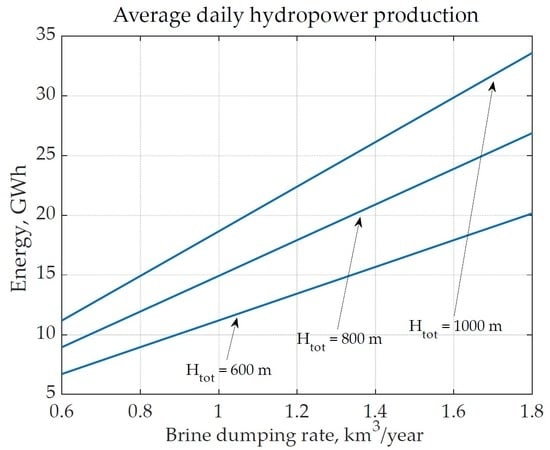
Figure 7.
The average daily electric hydropower production as per the different heights of brine dumping.
The electrical energy generated from conventional and renewable power stations can be used to produce fresh water and, as a co-product, some volume of brine. Today, the desalination procedure is mainly based on reverse osmosis, which is the most effective and cheapest technology in the Middle East region [50]. This technology uses the properties of the special osmosis membrane to pass fresh water through from a salted solution under pressure that overcomes some magnitude. Owing to this circumstance, this process requires energy, which is expressed in kilowatt-hours per cubic meter of fresh water. The energy demands water desalination [51,52] depend on the type of membrane configuration (the single- or two-stage water pass) and recovery coefficient (the ratio of the obtained freshwater to the total seawater volume). For the Mediterranean region, for a single stage pass and ~45% (Krec) of recovery coefficient, which is the most usable there, the energy demands are equal to Ewd = 4.2–4.5 kWh/m3 (~4.3 × 103, GWh/km3) of freshwater. These data were used in the present investigation.
Several requirements need to be fulfilled for daily energy generation in the system, including conventional and renewable PV power stations, seawater desalination facilities, and hydro-power storage plants (Figure 5). The first one of these determines the power balance, which provides the entire requirements of consumers through the summarized energy generation of conventional power stations and PV facilities:
The following constrain determines the required volume of a hydro-storage for covering an evening power peak:
where Pgen = (Pconv + PPV) represents the summarized electricity production of conventional power stations and PV plants; Pcons is the domestic power consumption; t1, t2 are the times in the integral (9) that depend on both electricity production and consumers demands; KPS (coefficient of pumping storage efficiency) defines the ratio of net electric storage energy to the energy applied to generate it. KPS can be determined by a ratio between the energy that is realized from brine dumping through the cascade of hydropower stations and the energy that has been consumed to raise seawater to the desalination facilities on mountain heights. The energy utilized for a desalination process was not considered in the presented expression since resulting in freshwater production had its own cost and, therefore, could be neglected.
The requirement of a summarized Pconv and PPV generation ensured that the daily peak of energy demands could be entirely covered:
The energy required for water lifting is summarized by the power needed to overcome the pressure of a water column and friction during the flow through pipes over the distance of their length. Following the guide of [53], the energy utilized for seawater lifting was equal to:
where ηpump signifies pumping efficiency (~0.8–0.85); ΔH is the difference between Mediterranean and Dead Sea levels (~400 m); represents the density of Mediterranean water ~ (1.02–1.03)∙103 kg/m3; Vsw denotes the volume of seawater for a day; (Td + t1 − t2) is the time of water pumping; is the coefficient of a laminar flow in the pipes including pipes with length L and diameter D, and the viscosity of a water solution μ.
The energy could be obtained through the dumping of brine (WHP) as:
where Krec is the coefficient of recovery showing the portion of freshwater obtained from seawater. Therefore, the coefficient of a pumping storage efficiency KPS that expressed the productivity of the hydro-pumping storage was as follows:
In principle, coefficient KPS shows how many kWh of electricity can be obtained from each kWh of the energy spent on seawater pumping. The bigger the KPS, the better it is represented in the energy system.
The magnitude of KPS for all internal coefficients in Equation (11), which were assumed as constants (for pipes length equal to a real ~60 km), was both the function of the total height Htot and daily seawater volume Vsw which could be calculated for pipes with a diameter of 2 m. Since the efficiency drops with the pumping altitude and the number of hydro-cascades, the expression for KPS could be obtained as:
This expression (15) was obtained with the consideration that for each 100 m of pumping or hydro-generation, the efficiency decreased exponentially. This function had a decreasing tendency with the growing production of brine and desalinated water. In turn, the brine volume was determined by the required amount of hydro-pumping storage release, as seen in Equation (10). The graph of KPS (15) vs. brine-year production is shown in Figure 8.
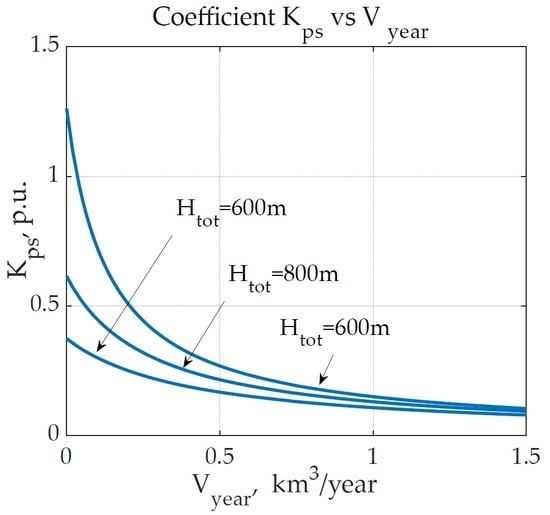
Figure 8.
The coefficient of the efficiency of a hydro-pumping storage as a function of the total height of brine dumping.
The represented curves prove the statement that for different brine volume production, the tendency of the efficiency of hydro-pumping storage had a dissimilar direction. For a rate of 0.257 km3/year of brine production, the lifting did not influence the KPS, which remained constant. A lower rate of brine production (less than 0.257 km3/year) led to increases in efficiency when seawater lifting was raised, whereas the higher rate caused the diminishing of the efficiency of hydro-pumping storage when the lifting height grew. Despite this negative tendency, the efficiency of pumping hydro-storage remains higher than that of a case with a lower rate of brine release.
It is worth noting the volume of freshwater that could be produced through the desalination process and the amount of electricity that needed to be consumed for this. The amount of freshwater (VFW) depended on the brine volume as follows:
The general quantity of daily electricity for the desalination can be assessed as follows:
Regarding everything mentioned above consideration, should be taken for the optimization of PV electricity generation.
4. Results
The research methodology described above allowed for the most efficient use of PV energy facilities. Three scenarios (Htot = 600, 800, and 1000 m) were taken for the investigation. For each height, the maximum total daily energy storage was determined = using Equation (8). This quantity of electricity is known as “storage energy realization”, or WSER. It is equal to the integral (18) (see Figure 5) in the time interval t2–t4:
This energy WSER must be equal to or greater than the residual from meeting the total energy demand with the help of conventional and solar power plants. As it seems from (18), WSER is a function of the ability of conventional stations and the power of PV facilities. This circumstance makes the analytical solution for the assessment of both power parameters (PV and grid generation) more difficult. However, it can be solved by a numerical approach that takes into consideration construction (10), restrictions (9), and (11). The additional restriction required is based on the consideration that even the minimum conventional power should surely be bigger than the minimum domestic energy demands at night. Together, conventional power should be equal to or slightly more than the maximum evening peak. Thus:
The coefficient of reliability KR ensured the consistency of the power supply (despite the stochastic behavior of consumers), which was assumed to be 1.3–1.4. This additional requirement is associated with the feasible range of power control in the conventional power network, which could be represented as a ratio between the minimum (Pmin) and maximum (Pmax) generating capability. Real energy generating facilities based on a standard cycle of fuel burning and vapor production with the following use of turbines to rotate synchronous generators could not operate in a wide range of powers without significant losses in efficiency. Considering this circumstance, some authors [54] introduced a parameter named the flexibility factor (ff) that is equal to:
In the Israeli electric industry in the years 2006–2010, ff was equal to 0.65. That is the range in which the power control lay between Pmax/Pmin < 2.85. The immense introduction of PV and other renewable sources with massive storage appliances allowed an efficiency increase in conventional power facilities. Therefore, the range of power control should be narrower, and the ratio Pmax/Pmin should not be bigger than 1.5–1.8. This range of possible power variations should be investigated.
Additional restrictions relating to the maximum allowable Dead Sea level increase that, due to ecological reasons, could not be more than ~35 m during the next 30 future years. Therefore, maximum brine dumping (Equation (6), Figure 4) should be 1.6 km3/year.
For the study of the influence of all involved parameters, special MATLAB software was developed. This software provided numerical solutions that are graphically represented below.
The influence of renewable electricity generation at some altitudes of seawater lifting can be seen in Figure 9, which shows the consistent decrement of conventional power diminishing with growing PV production.
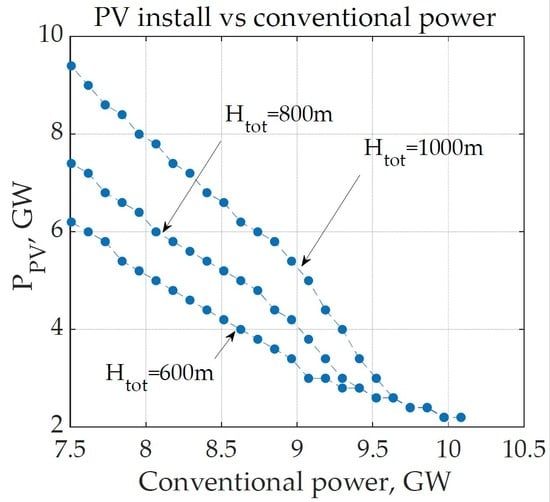
Figure 9.
The PV installation vs. the power of conventional stations.
The dependence on brine and freshwater production vs. conventional power is seen in Figure 10a,b. The tendency of potential freshwater (and brine) flow is non-monotonic with the change in seawater lifting for desalination. With the elevation in the seawater lifting height, the efficiency of the water pumping for raising and generating in the cascade of hydropower stations decreased. This circumstance should be considered in the development of a real project. Moreover, to this the required power of hydro-stations and total daily release of hydro-storage is clearly depicted in Figure 11a,b.
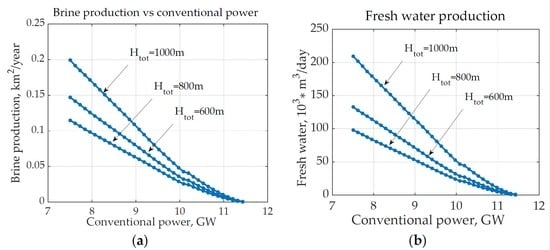
Figure 10.
The brine (a) and freshwater (b) production vs. power of conventional stations.

Figure 11.
Required power of hydro-stations and total daily release of hydro-storage: (a) Required power of hydro-stations; (b) Total hydro-storage daily release.
5. Discussion
The tendency toward increasing renewable energy production can lead to the identification of unusual techno-economic solutions that are able to neutralize the negative results of a massive introduction of PV facilities into domestic networks. In Israel, where the electrical industry is rather isolated and relatively small, the major answer to the PV problem is the use of energy storage technologies. Considering Israel’s geographic location in the vicinity of the Mediterranean and Dead Seas, the optimal solution seems to be the development of a channel between those seas. Additional important reasons can approve this decision. The first is a consistently growing gap of 400 m below the Dead Sea level under the worldwide ocean, which can be exploited to produce surplus electricity. The second reason is the rising demand for freshwater (desalinated) production due to the increasing population and industry. Altogether, including the requirements of energy storage for smoothing stochastic PV generation, the project of a channel between the Mediterranean and the Dead Sea is especially actual and valid. However, between both seas, the Judea Mountains are located, and this circumstance requires a special and precise investigation of the channel parameters influencing the outcomes of its functionality. This research was based on a detailed analysis of daily electricity consumption, solar possibilities to generate electrical power in the daytime, the feasibility of seawater desalination with reverse osmosis, energy expenditures for water pumping, and achievable generation in hydro-power stations. The obtained results show the following possibilities and advantages of the project: first, the optimal solution for electricity production should be a combination of conventional generating facilities (power stations based on burning fossil fuels) with PV plants and a cascade of hydropower stations. The optimal topology of the channel includes the placement of desalinating facilities on the heights of the Judea Mountains, for which the Mediterranean water can be lifted at a time characterized by a surplus of electricity. As a rule, this is a deep night with minimal energy consumption that is much smaller than the economically permissible minimum for conventional stations. Beyond that, it can be noontime when PV plants have a significant power surplus over consumption. Together with water feeding for desalination plants, a surplus of energy was spent on freshwater production and the accumulation of brine, as a co-product of a desalination process, in special ponds adjacent to a descent to the Dead Sea. Later, at the time of the evening consumption peak, the brine is dumped into the Dead Sea through a cascade of hydropower stations, and this way, stored hydropower can be realized. The following results were obtained depending on the total elevation difference of the hydro-power plants over the Dead Sea level. First, conventional generation based on fuel burning decreased by 35–40% at a minimum. Together with this, the flexibility factor of the electro-generating industry achieved a value of 0.16–0.17, meaning that the relation between maximally and minimally generated power was only 1.2, which provided an additional improvement to the efficiency of conventional stations. The total output of hydropower stations could reach 320–330 MW, and the output of installed PV plants was no less than 8–10 GW. This hydro-storage may daily provide 3.5–4 GWh, together with 150–180 × 103 m3 of freshwater production. An additional issue can be related to the accumulation of brine after desalination in the Dead Sea basin. The mixing of water from the Mediterranean with those of the Dead Sea is not dangerous since it causes the production of a relatively small amount of gypsum only that can precipitate at the bottom of the Dead Sea. However, considering the large area of the sea that was dried during the last period, the beginning of brine mixing with the Dead Sea water as a result of intensive evaporation will take many years ahead.
6. Conclusions
In conclusion, the installation of electrical storage systems can effectively address the issues brought about by rising solar electricity production in the Israeli energy industry. Among these potential solutions, the creation of a channel between the Mediterranean and the Dead Sea holds great promise. This channel can not only generate desalinated water to meet domestic, industrial, and agricultural needs but also prevent the permanent decline of the Dead Sea and create hydro-pumping electrical storage stations. Additionally, it can facilitate the development of numerous PV facilities in the Negev area for national electricity generation. However, further detailed analysis, including the stochastic PV outcome and the potential use of the Dead Sea for brine discharge from electrical hydro-storage plants, should be conducted to accurately estimate the increase in solar electric generation. By implementing innovative solutions such as the channel between the Mediterranean and the Dead Sea, Israel can effectively manage the challenges associated with the expansion of solar electricity production and ensure a sustainable energy future.
Author Contributions
Conceptualization, M.A. and S.L.; methodology, M.A. and A.S.; formal analysis, A.S.; investigation, S.L.; data curation, S.L.; writing—original draft preparation, M.A.; writing—review and editing, A.S.; supervision, M.A.; project administration, S.L. All authors have read and agreed to the published version of the manuscript.
Funding
This research received no external funding.
Data Availability Statement
The authors will provide the data upon request from the readers of this article.
Conflicts of Interest
The authors declare no conflict of interest.
References
- Macedo, S.F.; Peyerl, D. Prospects and economic feasibility analysis of wind and solar photovoltaic hybrid systems for hydrogen production and storage: A case study of the Brazilian electric power sector. Int. J. Hydrogen Energy 2022, 47, 10460–10473. [Google Scholar] [CrossRef]
- Spyridonidou, S.; Sismani, G.; Loukogeorgaki, E.; Vagiona, D.G.; Ulanovsky, H.; Madar, D. Sustainable spatial energy planning of large-scale wind and PV farms in Israel: A collaborative and participatory planning approach. Energies 2021, 14, 551. [Google Scholar] [CrossRef]
- Prados, M.; Iglesias-Pascual, R.; Barral, Á. Energy transition and community participation in portugal, greece and israel: Regional differences from a multi-level perspective. Energy Res. Soc. Sci. 2022, 87, 102467. [Google Scholar] [CrossRef]
- Ashwarya, S. Israel’s Renewable Energy Strategy: A Review of its Stated Goals, Current Status, and Future Prospects. Percept. J. Int. Aff. 2021, 26, 321–340. [Google Scholar]
- Milstein, I.; Tishler, A.; Woo, C. Wholesale electricity market economics of solar generation in Israel. Util. Policy 2022, 79, 101443. [Google Scholar] [CrossRef]
- Guttikunda, S.K.; Jawahar, P. Atmospheric emissions and pollution from the coal-fired thermal power plants in India. Atmos. Environ. 2014, 92, 449–460. [Google Scholar] [CrossRef]
- Shu, Y.; Hu, J.; Zhang, S.; Schöpp, W.; Tang, W.; Du, J.; Cofala, J.; Kiesewetter, G.; Sander, R.; Winiwarter, W. Analysis of the air pollution reduction and climate change mitigation effects of the Three-Year Action Plan for Blue Skies on the “2 26” Cities in China. Environ. Manag. 2022, 317, 115455. [Google Scholar] [CrossRef]
- Arcos-Vargas, A.; Cansino, J.M.; Román-Collado, R. Economic and environmental analysis of a residential PV system: A profitable contribution to the Paris agreement. Renew. Sustain. Energy Rev. 2018, 94, 1024–1035. [Google Scholar] [CrossRef]
- Glenk, G.; Meier, R.; Reichelstein, S. Cost dynamics of clean energy technologies. Schmalenbach J. Bus. Res. 2021, 73, 179–206. [Google Scholar] [CrossRef]
- Branker, K.; Pathak, M.; Pearce, J.M. A review of solar photovoltaic levelized cost of electricity. Renew. Sustain. Energy Rev. 2011, 15, 4470–4482. [Google Scholar] [CrossRef]
- Comello, S.; Reichelstein, S.; Sahoo, A. The road ahead for solar PV power. Renew. Sustain. Energy Rev. 2018, 92, 744–756. [Google Scholar] [CrossRef]
- Balali, M.H.; Nouri, N.; Omrani, E.; Nasiri, A.; Otieno, W. An overview of the environmental, economic, and material developments of the solar and wind sources coupled with the energy storage systems. Int. J. Energy Res. 2017, 41, 1948–1962. [Google Scholar] [CrossRef]
- Rajput, S.; Amiel, I.; Sitbon, M.; Aharon, I.; Averbukh, M. Control the Voltage Instabilities of Distribution Lines using Capacitive Reactive Power. Energies 2020, 13, 875. [Google Scholar] [CrossRef]
- Amiel, I.; Rajput, S.; Averbukh, M. Capacitive reactive power compensation to prevent voltage instabilities in distribution lines. Int. J. Electr. Power Energy Syst. 2021, 131, 107043. [Google Scholar] [CrossRef]
- Sultan, H.M.; Diab, A.A.Z.; Kuznetsov, O.N.; Ali, Z.M.; Abdalla, O. Evaluation of the impact of high penetration levels of PV power plants on the capacity, frequency and voltage stability of Egypt’s unified grid. Energies 2019, 12, 552. [Google Scholar] [CrossRef]
- Yan, R.; Saha, T.K. Investigation of voltage stability for residential customers due to high photovoltaic penetrations. IEEE Trans. Power Syst. 2012, 27, 651–662. [Google Scholar] [CrossRef]
- Saidi, A.S. Impact of grid-tied photovoltaic systems on voltage stability of unisian distribution networks using dynamic reactive power control. Ain Shams Eng. J. 2022, 13, 101537. [Google Scholar] [CrossRef]
- Zhou, H.; Yan, X.; Liu, G. A review on voltage control using on-load voltage transformer for the power grid. IOP Conf. Ser. Earth Environ. Sci. 2019, 252, 032144. [Google Scholar] [CrossRef]
- Alam, M.; Chowdhury, T.A.; Dhar, A.; Al-Ismail, F.S.; Choudhury, M.; Shafiullah, M.; Hossain, M.; Ullah, A.; Rahman, S.M. Solar and Wind Energy Integrated System Frequency Control: A Critical Review on Recent Developments. Energies 2023, 16, 812. [Google Scholar] [CrossRef]
- Mansouri, N.; Lashab, A.; Sera, D.; Guerrero, J.M.; Cherif, A. Large photovoltaic power plants integration: A review of challenges and solutions. Energies 2019, 12, 3798. [Google Scholar] [CrossRef]
- Uzum, B.; Onen, A.; Hasanien, H.M.; Muyeen, S. Rooftop solar pv penetration impacts on distribution network and further growth factors—A comprehensive review. Electronics 2020, 10, 55. [Google Scholar] [CrossRef]
- Rajan, R.; Fernandez, F.M.; Yang, Y. Primary frequency control techniques for large-scale PV-integrated power systems: A review. Renew. Sustain. Energy Rev. 2021, 144, 110998. [Google Scholar] [CrossRef]
- Shafiullah, M.; Ahmed, S.D.; Al-Sulaiman, F.A. Grid Integration Challenges and Solution Strategies for Solar PV Systems: A Review. IEEE Access 2022, 10, 52233–52257. [Google Scholar] [CrossRef]
- Zhang, Q.; Mao, M.; Ke, G.; Zhou, L.; Xie, B. Stability problems of PV inverter in weak grid: A review. IET Power Electron. 2020, 13, 2165–2174. [Google Scholar] [CrossRef]
- Solomon, A.A.; Faiman, D.; Meron, G. Grid matching of large-scale wind energy conversion systems, alone and in tandem with large-scale photovoltaic systems: An Israeli case study. Energy Policy 2010, 38, 7070–7081. [Google Scholar] [CrossRef]
- Luo, X.; Wang, J.; Dooner, M.; Clarke, J. Overview of current development in electrical energy storage technologies and the application potential in power system operation. Appl. Energy 2015, 137, 511–536. [Google Scholar] [CrossRef]
- Akinyele, D.; Rayudu, R. Review of energy storage technologies for sustainable power networks. Sustain. Energy Technol. Assess. 2014, 8, 74–91. [Google Scholar] [CrossRef]
- Azzuni, A.; Breyer, C. Energy security and energy storage technologies. Energy Procedia 2018, 155, 237–258. [Google Scholar] [CrossRef]
- Jacobson, M.Z.; Delucchi, M.A.; Cameron, M.A.; Frew, B.A. Low-cost solution to the grid reliability problem with 100% penetration of intermittent wind, water, and solar for all purposes. Proc. Natl. Acad. Sci. USA 2015, 112, 15060–15065. [Google Scholar] [CrossRef]
- Jacobson, M.Z.; Delucchi, M.A. Providing all global energy with wind, water, and solar power, part I: Technologies, energy resources, quantities and areas of infrastructure, and materials. Energy Policy 2011, 39, 1154–1169. [Google Scholar] [CrossRef]
- Aliyu, M.; Hassan, G.; Said, S.A.; Siddiqui, M.U.; Alawami, A.T.; Elamin, I.M. A review of solar-powered water pumping systems. Renew. Sustain. Energy Rev. 2018, 87, 61–76. [Google Scholar] [CrossRef]
- Sontake, V.C.; Kalamkar, V.R. Solar photovoltaic water pumping system—A comprehensive review. Renew. Sustain. Energy Rev. 2016, 59, 1038–1067. [Google Scholar] [CrossRef]
- Ma, T.; Yang, H.; Lu, L. Feasibility study and economic analysis of pumped hydro storage and battery storage for a renewable energy powered island. Energy Convers. Manag. 2014, 79, 387–397. [Google Scholar] [CrossRef]
- Blakers, A.; Stocks, M.; Lu, B.; Cheng, C. A review of pumped hydro energy storage. Prog. Energy 2021, 3, 022003. [Google Scholar] [CrossRef]
- Hunt, J.D.; Zakeri, B.; Lopes, R.; Barbosa, P.S.F.; Nascimento, A.; de Castro, N.J.; Brandão, R.; Schneider, P.S.; Wada, Y. Existing and new arrangements of pumped-hydro storage plants. Renew. Sustain. Energy Rev. 2020, 129, 109914. [Google Scholar] [CrossRef]
- Hunt, J.D.; Byers, E.; Wada, Y.; Parkinson, S.; Gernaat, D.E.; Langan, S.; van Vuuren, D.P.; Riahi, K. Global resource potential of seasonal pumped hydropower storage for energy and water storage. Nat. Commun. 2020, 11, 947. [Google Scholar] [CrossRef]
- Fang, W.; Huang, Q.; Huang, S.; Yang, J.; Meng, E.; Li, Y. Optimal sizing of utility-scale photovoltaic power generation complementarily operating with hydropower: A case study of the world’s largest hydro-photovoltaic plant. Energy Convers. Manag. 2017, 136, 161–172. [Google Scholar] [CrossRef]
- Ming, B.; Liu, P.; Guo, S.; Zhang, X.; Feng, M.; Wang, X. Optimizing utility-scale photovoltaic power generation for integration into a hydropower reservoir by incorporating long- and short-term operational decisions. Appl. Energy 2017, 204, 432–445. [Google Scholar] [CrossRef]
- Ma, T.; Yang, H.; Lu, L.; Peng, J. An optimization sizing model for solar photovoltaic power generation system with pumped storage. Energy Procedia 2014, 61, 5–8. [Google Scholar] [CrossRef]
- Cipollina, A.; Micale, G.; Rizzuti, L. Seawater Desalination: Conventional and Renewable Energy Processes; Springer Science & Business Media: Berlin/Heidelberg, Germany, 2009. [Google Scholar]
- Chafik, E. A new type of seawater desalination plants using solar energy. Desalination 2003, 156, 333–348. [Google Scholar] [CrossRef]
- Shim, W.G.; He, K.; Gray, S.; Moon, I.S. Solar energy assisted direct contact membrane distillation (DCMD) process for seawater desalination. Sep. Purif. Technol. 2015, 143, 94–104. [Google Scholar] [CrossRef]
- Chen, L.; Lam, W. A review of survivability and remedial actions of tidal current turbines. Renew. Sustain. Energy Rev. 2015, 43, 891–900. [Google Scholar] [CrossRef]
- Available online: https://icl-group-sustainability.com/reports/dead-sea-water-level/ (accessed on 14 May 2023).
- Available online: https://water.fanack.com/publications/red-sea-dead-sea-project/ (accessed on 14 May 2023).
- Salhotra, A.M.; Adams, E.E.; Harleman, D.R. Effect of salinity and ionic composition on evaporation: Analysis of Dead Sea evaporation pans. Water Resour. Res. 1985, 21, 1336–1344. [Google Scholar] [CrossRef]
- Chen, C.; Kuang, Y.; Hu, L. Challenges and opportunities for solar evaporation. Joule 2019, 3, 683–718. [Google Scholar] [CrossRef]
- Chang, J.; Li, Y.; Yuan, M.; Wang, Y. Efficiency evaluation of hydropower station operation: A case study of Longyangxia station in the Yellow River, China. Energy 2017, 135, 23–31. [Google Scholar] [CrossRef]
- Kress, N.; Gertner, Y.; Shoham-Frider, E. Seawater quality at the brine discharge site from two mega size seawater reverse osmosis desalination plants in Israel (Eastern Mediterranean). Water Res. 2020, 171, 115402. [Google Scholar] [CrossRef]
- Available online: https://www.gov.il/en/departments/publications/reports/potential_for_solar_production_on_existing_structures_jan_2020 (accessed on 14 May 2023).
- Stover, R.L. Seawater reverse osmosis with isobaric energy recovery devices. Desalination 2007, 203, 168–175. [Google Scholar] [CrossRef]
- Kim, J.; Park, K.; Yang, D.R.; Hong, S. A comprehensive review of energy consumption of seawater reverse osmosis desalination plants. Appl. Energy 2019, 254, 113652. [Google Scholar] [CrossRef]
- Watton, J. Fundamentals of Fluid Power Control; Cambridge University Press: Cambridge, UK, 2009. [Google Scholar]
- Solomon, A.A.; Faiman, D.; Meron, G. Properties and uses of storage for enhancing the grid penetration of very large photovoltaic systems. Energy Policy 2010, 38, 5208–5222. [Google Scholar] [CrossRef]
Disclaimer/Publisher’s Note: The statements, opinions and data contained in all publications are solely those of the individual author(s) and contributor(s) and not of MDPI and/or the editor(s). MDPI and/or the editor(s) disclaim responsibility for any injury to people or property resulting from any ideas, methods, instructions or products referred to in the content. |
© 2023 by the authors. Licensee MDPI, Basel, Switzerland. This article is an open access article distributed under the terms and conditions of the Creative Commons Attribution (CC BY) license (https://creativecommons.org/licenses/by/4.0/).